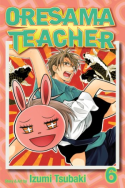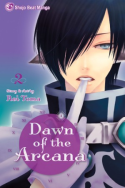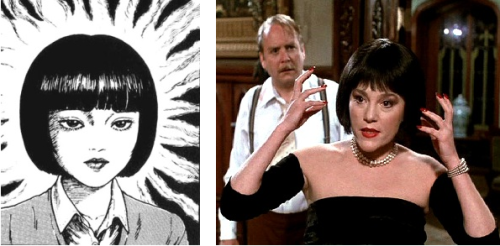Originally, this post was supposed to go up several months ago, when the sixth volumes of these series were newly released, but time conspired against me. And so, belatedly, I present reviews of volumes five and six of Kamisama Kiss and Oresama Teacher. Also included is perennial favorite Skip Beat!, which is on a similar trajectory, just twenty volumes ahead.
 Kamisama Kiss, Vols. 5-6
Kamisama Kiss, Vols. 5-6
It’s hard to believe now that I ever had my doubts about Kamisama Kiss, because I’m enjoying it more and more with each volume.
Volume five finds Nanami determined to correct public opinion that her shrine is a creepy, dangerous ruin, especially since her shinshi, Tomoe, works so hard to maintain it. And so, she decides to hold a festival, spending two weeks preparing for a special performance while soliciting amusingly misguided advice from her supernatural acquaintances. It’s a success in the end. In volume six, Nanami is called upon to compete against another human girl for a spot at a prestigious kami conference.
In these two volumes, mangaka Julietta Suzuki nicely balances the expansion of the supernatural world (including the introduction of several new characters) and Nanami’s abilities with further development in her relationship with Tomoe. It seems to me that Tomoe is finding himself somewhat in awe of his kami these days—particularly when purification powers on par with his first master’s manifest themselves—and also more prone to emotions like fondness and jealousy. One of the best things about their relationship is how he is able to encourage and reassure her before the festival without being condescending about it. “I acknowledged you as my master,” he says. “Don’t be afraid. Prove yourself to everyone… like you did to me.”
I think the main appeal for me is that Kamisama Kiss is shaping up to be the story of Nanami’s growth. She may be in love with Tomoe, but winning his affections is not her sole ambition, or even her focus. Instead, she wants to develop as a kami and become someone that her parishioners can depend upon and respect. Because progress has come slowly, watching her actually achieve some truly remarkable things in these volumes actually leaves me a little verklempt. This has become less a story about a human girl thrust into the wacky world of yokai and more about someone embracing their destiny and striving to reach their full potential. I eagerly look forward to the next volume.
 Oresama Teacher, Vols. 5-6
Oresama Teacher, Vols. 5-6
I was worried there for a minute. It seemed to me that volume five was showing signs of Tsubaki-sensei running out of ideas, what with a chapter about Takaomi and Mafuyu helping a wealthy girl find love with her self-denying servant, a chapter about the school’s bancho being stalked by a flower fairy, and a chapter about the Student Council’s resident ninja gathering intel on the Public Morals Club.
Although it’s not the neatest bow—I still don’t fully grasp why the Student Council is so opposed to Takaomi’s plans to attract more non-delinquent students to Midorigaoka, but at least I have an inkling now—Tsubaki does manage to tie things together by the end of volume six. Okay, not the flower fairy bit, but the significance of Takaomi going out of his way to help Marika (the rich girl) ties in with the backstory of why he’s become a teacher and why he’s made a bet with the school’s director. It brings new depth to his character and even relates to some things he said back in volume one.
I also really enjoyed the chapter in which the members of the Public Morals Club—now including Shinobu the ninja, who has decided to obtain information on his enemies from within their midst—explore the school, finding oodles of empty classrooms and realizing that it was once a thriving place with high-caliber students. Also significant is that, when Mafuyu is frustrated by Takaomi refusal to reveal his true motivations, she complains that all she’d wanted was to be a regular high school girl, but then got forcibly recruited to his agenda. Hayasaka overhears and, thinking he has kept Mafuyu from the life she’d wished for, avoids her. Mafuyu attempts to hang out with some girls, but in the end realizes she prefers being with Hayasaka. It’s really sweet.
This description might make it sound as if the series has suddenly gone in a plot-heavy direction, but that’s not really the case. There’s definitely something happening, but there are still plenty of amusing moments. My favorite is when Hayasaka and Super Bun are reunited and we get a panel of her carrying him in her arms while he thinks, “You’re so dreamy!”
 Skip Beat!, Vols. 25-26
Skip Beat!, Vols. 25-26
It’s a rare series that still genuinely delights me this far into its run, but Skip Beat! consistently manages to do so. I think the key here is that Nakamura has developed a cast of characters whose personality quirks enable her to take the plot in unexpected directions.
For example, volume 25 is all about the aftermath of Valentine’s Day. Sho has learned that Kyoko gave chocolates to Reino, and so shows up on the set of Dark Moon with an ostentatious bouquet in hand. He’s not out to win Kyoko’s love—so her explanation of the true nature of the chocolates (hatred) makes no difference—he just wants all her thoughts to be focused on him once more, and he temporarily ensures this by stealing her first kiss. Kyoko freaks out, according to plan, and is briefly talked down by Ren, but when she gives Ren his own special valentine, he can’t resist driving thoughts of Sho out of her head by administering a smooch of his own. This one’s on the cheek and he plays it off as a foreigner’s expression of gratitude, but it definitely leaves a trace in her heart.
Backing away from all of this progress, Nakamura eases us into the next arc by having Kyoko and Kanae return to the Love-Me Section, where they are joined by new member Chiori Amamiya, a former child actress whom Kyoko recently inspired to regain her love for acting. Each girl receives a personalized assignment from Lory, and Kyoko’s involves picking up Cain Heel, a dangerous-looking guy who is the president’s guest. Turns out, this is Ren going undercover and Kyoko’s new assignment is to stay by his side as his doting and scantily clad goth sister, Setsuka. And they have to live together in a hotel room. Ordinarily, a twist like this would be completely out of left field, but because this is Lory and because this is Skip Beat! I can just roll with it and eagerly anticipate the complications that will ensue.
If you’ve never read Skip Beat! before, now is a great time to start, as an omnibus edition of the first three volumes has recently been released!
Review copies provided by the publisher.

























Recent Comments